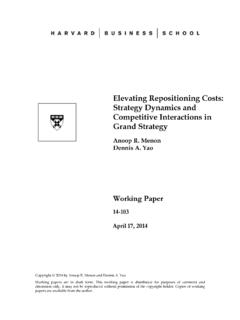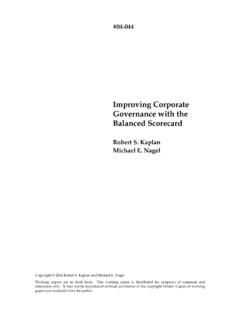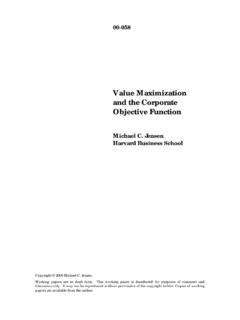Transcription of Creating the Office of Strategy Management
1 Paper 05-071 Copyright 2005. Working papers are in draft form. This working paper is distributed for purposes of comment and discussion only. It may not be reproduced without permission of the copyright holder. Copies of working papers are available from the author. Creating the Office of Strategy Management Robert S. Kaplan David P. Norton Creating the Office of Strategy Management Robert S. Kaplan David P. Norton April 2005 Organizations often fail at Strategy execution. Various sources have reported implementation failure rates at between 60 and 90 percent. A Bain Consulting study of large companies in eight industrialized countries found that seven out of eight companies failed to achieve profitable growth between 1988-1998, defined, rather modestly, as annual real growth in revenues and earnings, with returns that exceeded their cost of capital.
2 Interestingly, 90% of companies in the Bain study had strategic plans with targets exceeding these growth targets; few achieved For the past 15 years, we have studied companies that achieved performance breakthroughs by placing the Balanced Scorecard as the centerpiece of a new Strategy Management system. The successful companies align their key Management processes for effective Strategy execution. Many of these companies have now sustained their focus on Strategy execution by establishing a new corporate-level unit, an Office of Strategy Management (OSM). Not all organizations, however, have understood the need for a corporate-level Office to align existing Management processes to Strategy . Companies, after developing Balanced Scorecards, often make a major error by continuing to plan, allocate resources, budget, report, communicate, and review performance as they had in the past.
3 Fragmented Management Processes Consider the Management calendar shown in Figure 1, with diverse Management processes done by different units at different times of year without the guidance from an integrated, consistent view of Strategy . The process starts sometime in the middle of the fiscal year, when the strategic planning department organizes a multi-day offsite meeting for the executive leadership team to update Strategy based on a review of the company s strengths, weaknesses, opportunities, and threats, and in light of changing circumstances and the new knowledge gained since the last Strategy meeting, a year ago. As valuable as these planning sessions are, executives lack a simple framework for communicating the updated Strategy to others. Subsequently, individual business units and shared service units, such as human resources and information technology, do their own annual strategic planning updates.
4 The strategies of these units are typically not informed by the corporate Strategy and therefore they do not reflect how the units must work together to achieve integration and synergy. Our research reveals that 67 percent of HR and IT organizations are not aligned 1 Chris Zook, with James Allen, Profit from the Core (Boston, MA: Harvard Business School Press, 2001). with business unit and corporate strategies, and their departmental plans do not support corporate or business unit strategic initiatives. During the third and fourth quarters, the finance department runs the annual budgeting process that authorizes next year s spending on operations, discretionary programs, and capital investments, and establishes next year s targets for financial metrics, such as revenues, expenses, operating margins, and profits.
5 Again this process is typically uninformed by the strategic plan; sixty percent of organizations do not link their financial budgets to strategic priorities. At the end of the year, the human resources department runs annual performance reviews for all employees, determines their bonus and incentive awards, and has all employees update their objectives and plans for the subsequent year. But 70 percent of middle managers and more than 90 percent of front line employees do not have incentive compensation tied to successful Strategy implementation. Throughout the subsequent year, senior executives meet at least monthly to review progress against the budget, and initiate actions to meet short-term targeted performance. Such discussions invariably focus on short-term operations, fire-fighting, and tactics.
6 Eighty-five percent of executive leadership teams report that they spend less than one hour per month discussing their unit s Strategy and 50 percent indicate they spend zero time on Strategy discussions. Meanwhile, the internal communications group sends continual messages to employees about the company. But these messages have little to do with business unit and corporate Strategy . Ninety-five percent of employees claim they are not aware of or do not understand the Strategy . If employees who are closest to the customers and who operate the processes that create value for customers and shareholders are unaware of the Strategy , they cannot help the organization implement it. Finally, corporate knowledge sharing typically focuses on process improvement opportunities. Little systematic attention and resources are devoted to capturing knowledge and best-practices that might support effective Strategy implementation.
7 With responsibilities for Strategy Management so diffuse and uncoordinated, the high failure rate for Strategy execution is not a surprise. The Emerging Office of Strategy Management Most companies initially view the Balanced Scorecard as a project, to be led by a multi-functional project team. At the end of Creating scorecards for the company and various business units, the project team leader becomes the custodian of the scorecard, with a title such as Vice President, Balanced Scorecard or Director, Global Reporting. This scorecard manager oversees the valid, timely reporting of scorecard measures and serves as the corporate consultant for questions about the scorecard. But for many companies, this is the end of their Balanced Scorecard project. They have a new 2 measurement system, but they have not changed any Management processes to capitalize on it.
8 The successful companies, in contrast, transform key Management processes to focus on Strategy execution. They sustain the focus by elevating their Balanced Scorecard project team into a new corporate-level Office , which we call the Office of Strategy Management (OSM). The emergence of this new Office made us aware of a gap in most organizations Management structures. All organizations have offices that manage finances, human resources, information technology, marketing, strategic planning, and quality. But few have an Office or department with prime responsibility for managing Strategy . While ultimately Strategy execution is the responsibility of line managers and employees, the evidence illustrated in Figure 1 reveals that without central guidance and coordination, Strategy is either omitted from key Management processes or Management processes are uncoordinated across functions and business units, leading to poor Strategy execution.
9 Organizations rarely get started with a fully-functioning Office of Strategy Management (the experience of Canadian Blood Services, reported at the end of this article, is an exception). Take the example of Chrysler Group. After a string of successes in the 1990s, Chrysler hit an innovation dry spell. The economic down-turn, rising costs and encroaching imports led to a forecasted CY2001 deficit of more than $5 billion. A new CEO, Dr. Dieter Zetsche, took charge. He worked with Bill Russo, vice president of business Strategy , and the executive team, to craft a new Strategy that featured both sharp cost cutting in the short-term (reducing the actual CY2001 deficit by $3 billion) and substantial investments to create great new products. Russo s Strategy group worked with the executive team to translate the Strategy into a Balanced Scorecard.
10 The group then served as trainer and consultant to help Chrysler s business and support units create local scorecards, aligned with corporate objectives, and customized to their local operations. Once this initial phase of design and cascading had been completed, Russo s group maintained responsibility for the data collection and reporting processes for the scorecard. This was a typical evolution for a Balanced Scorecard project. The Strategy group, however, also took on the responsibility for preparing the materials to communicate the new Chrysler Strategy and scorecard to all employees. And soon Dr. Zetsche began to ask Russo, before each Management meeting, to brief him about issues revealed by the scorecard that required attention and action. Russo, as a member of executive team, followed up after the meeting to ensure that the required actions were communicated and acted upon.
















